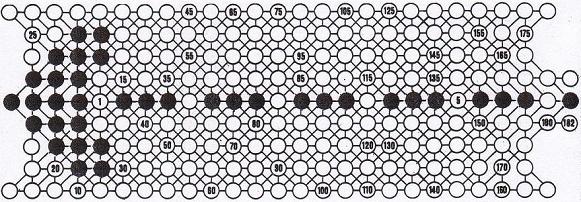
Michel Duloquin's 5T# grid of 182 moves as published by Pierre Berloquin in Science & Vie, May 1975, page 134.
Published as a game: will you succeed in completing the missing numbers of moves?
(click on the image to enlarge it)
Morpion Solitaire - Record Grids with another initial pattern (5T# and 5D# games)
In the 5T and 5D games, the initial pattern is a cross using 36 dots. But is it possible to get a better score than the current records of 178 moves (5T) and 82 moves (5D) from another initial pattern using the same number of dots (36)? The answer is not obvious, it is difficult to find a better pattern, but the answer is yes!
|
Game |
Moves |
Creator |
Date |
|
5T# |
178 |
Christopher D. Rosin (1) |
|
|
182 |
Michel Duloquin |
May 1975 (2) |
|
|
185 (3) |
Robert Féron |
November 1975 (2) |
|
|
187 |
Marc Lapierre |
February 2008 |
|
|
190 |
Christian Boyer |
November 2013 |
|
|
5D# |
82 |
Christopher D. Rosin (1) |
|
|
100 |
Christian Boyer |
February 2008 |
|
|
101 |
Christian Boyer |
January 2010 |
|
|
102 |
Peter Bartsch |
August 2010 |
|
(1) Current world records with the
standard initial pattern
(2) Publication or announcement date in
Science & Vie
(3) 186 moves announced by mistake in Science &
Vie
Who will find a grid with more than 190 moves (5T#) or more than 102 moves (5D#) from an initial pattern using 36 dots? Send me a message!
The first published 5T# example is a very nice symmetrical grid giving 182 moves, created in 1975 by M. Duloquin of Bry sur Marne. His full first name was not given in Science & Vie, but I succeeded in finding him in February 2010: 35 years after the publication of his grid, he was very surprised by my phone call... His first name is Michel.

Michel
Duloquin's 5T# grid of 182 moves as published by Pierre Berloquin in Science &
Vie, May 1975, page 134.
Published as a game: will you succeed in completing
the missing numbers of moves?
(click on the image to enlarge it)
Robert Féron (1921 -
) in 1978 and 2009
Six months later, in November 1975, Pierre Berloquin announced in Science & Vie a better grid of 186 moves by R. Féron, unfortunately without publishing it. I was able to find this grid in Berloquin's archives! And thanks to the letter dated May 20th 1975 associated with the grid, this mysterious "R. Féron" was in fact Robert Féron, professor at the Université de Lyon, member since 1946 of the Société Mathématique de France, famous for his research on probability and statistics (on him, see the paper of Jean-Paul Auray and Henri Prade published in 2008 in Advances in Soft Computing, and the PDF file on his works on random fuzzy sets by Henri Prade, IRIT CNRS). Robert Féron remained a professor at this University until his retirement in 1986. Here is his small piece of ruled paper:
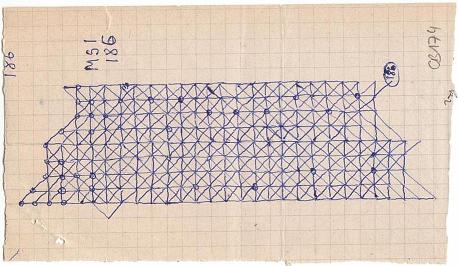
Original
of the 5T# grid of "186" moves by Robert Féron, sent to Pierre
Berloquin in 1975
(click on the image to enlarge it)
At first glance, we may think that he made a mistake, because we can discern (with difficulty) 37 initial dots instead of 36. But, after careful checking, we see he used only 36 dots. On the other hand, his real score is only 185 moves, instead of 186 as announced. Here is his grid, as I have reconstructed it:
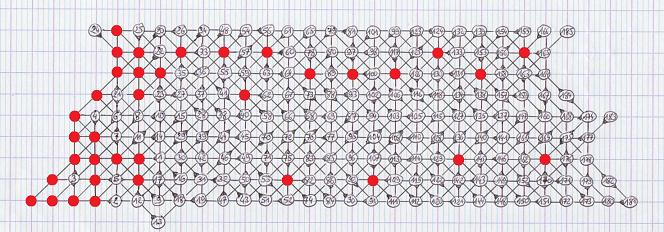
5T# grid of 185
moves by Robert Féron, rebuilt in February 2010 by Christian Boyer
(click on the image to enlarge it)
 Marc Lapierre (Versailles 1970 -) in 2007
Marc Lapierre (Versailles 1970 -) in 2007
In February 2008, Marc Lapierre, software engineer at Longrine (France), author of http://croix2malte.free.fr/indexGB.php (5T) and http://croix2malte.free.fr/NT/indexGB.php (5D), constructed this grid of 187 moves, inspired by Duloquin's grid.
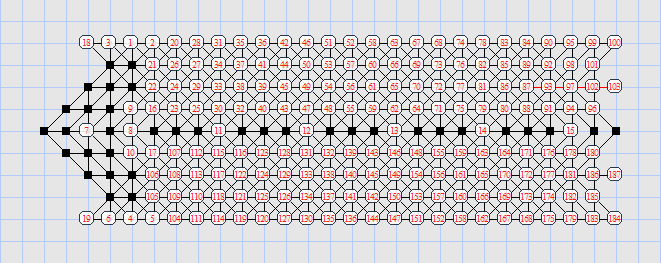
February 2008: 5T# grid of 187 moves by
Marc Lapierre.
(click on the image to enlarge it)
Then in November 2013, I obtained this score of 190 moves, by hand. This is the current record!
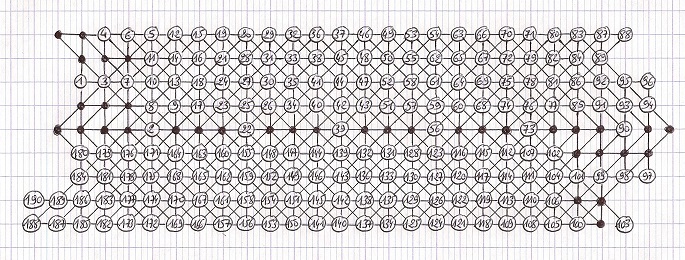
November 2013: 5T# grid of 190 moves by
Christian Boyer.
(click on the image to enlarge it)
My first best 5D# score from a pattern of 36 dots was initially 100 moves, with this grid:

February
2008: 5D# grid of 100 moves by
Christian Boyer.
(click on the image to enlarge it)
later slightly improved with one more move:

January
2010: 5D# grid of 101 moves by
Christian Boyer.
(click on the image to enlarge it)
 Peter Bartsch in 2010 (West-Berlin 1947 - )
Peter Bartsch in 2010 (West-Berlin 1947 - )
Then, Peter Bartsch, Germany, improved again the score with one more move, directly using my above pattern of 36 dots. Congratulations to him... and hmmm... shame on me to have been unable to find this solution from my own pattern!

August
23rd, 2010: 5D# grid of 102 moves by
Peter Bartsch.
(click on the image to enlarge it)
© Christian Boyer, www.morpionsolitaire.com